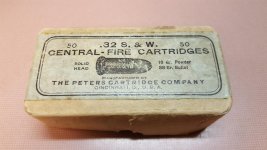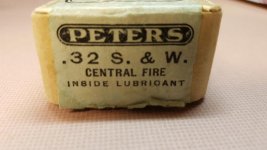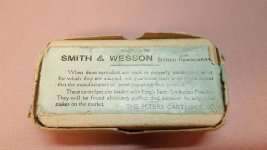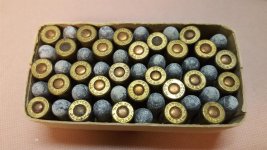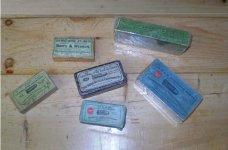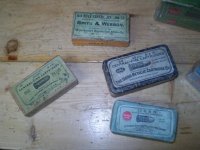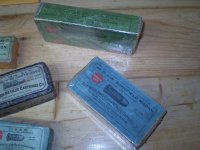Stop by my LGS today and picked up a 50 round box of 32 S&W Central-Fire Cartridges. I don't (yet) have a 32 S&W but keep looking at the older revolvers thinking that one would be fun to play with. What surprised me was the label called them Central-Fire instead of the current Center-Fire.
You are using an out of date browser. It may not display this or other websites correctly.
You should upgrade or use an alternative browser.
You should upgrade or use an alternative browser.
32 S&W Central- Fire Cartridges
- Thread starter Bob L
- Start date
Register to hide this ad
Beecherkid
Member
I would guess they are black powder cartridges. The label stating 10 Gr powder suggests that to me.
mmaher94087
SWCA Member
Old timey words. That box is like a "Baker's Dozen"; 51 rounds for the price of 50.
I would guess they are black powder cartridges. The label stating 10 Gr powder suggests that to me.
I did notice the box stated semi-smokeless powder.
Beecherkid
Member
I did notice the box stated semi-smokeless powder.
What exactly is a semi-smokeless powder?
Last edited:
LoboGunLeather
US Veteran
What exactly is a semi-smokeless powder?
The change from black powder cartridges to smokeless did not occur suddenly overnight. There were several years of various efforts toward producing ammunition with newer propellant powders. Not all were successful and not all were problem-free. Note the many firearms produced during the early 20th Century with manufacturers' markings indicating suitability for smokeless powders. Also note the large numbers of firearms damaged or destroyed when used with the newer ammunition types.
Even after several decades there remained a lot of folks who weren't completely convinced that the new-fangled smokeless powders were such a great idea. Many people continued handloading their own ammunition with black powder, just like Dad and Grandpa taught them.
Smokeless powder ammunition first appeared during the 1890's. Fine German rifles and ammunition were very popular over a large part of the planet. British makers were strong in the game as well. The .30 US Government cartridge (.30-40 Krag in popular parlance) came along with the 1892 Springfield bolt-action rifles, and the .30 Winchester Center Fire (.30-30 common terminology) was announced with the new Model 1894 Winchester rifles (quickly followed by the .32 Winchester Special, a cartridge considered much more suitable for reloading with black powder, a common practice for decades).
Lots of marketing and advertising was going on, with claims of superiority in propellant powders, priming, bullet technologies (like the new jacketed bullets of the time). "Semi-smokeless" is most likely one of those marketing efforts, but determining the exact composition of the powder might be difficult today.
Beecherkid
Member
LoboGunLeather: Thanks for the reply to my question.
"Semi-smokeless" is most likely one of those marketing efforts, but determining the exact composition of the powder might be difficult today.
I thought it might be a marketing effort or some type of blending of black powder. What ever it was , 10 grains in a little .32 S&W cartridge seems like a very high amount for anything smokeless.
"Semi-smokeless" is most likely one of those marketing efforts, but determining the exact composition of the powder might be difficult today.
I thought it might be a marketing effort or some type of blending of black powder. What ever it was , 10 grains in a little .32 S&W cartridge seems like a very high amount for anything smokeless.
Semi-smokeless powder wasn't just a marketing ploy, it was a real product that consisted of charcoal and nitrocellulose, so it had some characteristics of both smokeless and black powder. Whether it had any advantages is unclear to me. It also does not appear to be a transitional product as smokeless powders like Bullseye and Unique were already available when semi-smokeless was introduced.
I think that Central Fire was a common term used by almost all ammunition manufacturers in the late 1800s & early 1900s. It appears that the original term was used to differentiate rimfire from centerfire, but calibers that were never found in rimfire also used the same term. I have grabbed some boxes that state "Central Fire" and among them is a 45-70 and 45 Schofield box from sometime after 1912.
It seems that the term "Centerfire" may have started well after the introduction of smokless powder introduction, maybe around 1915? It would be interesting to know why the change was made??
It seems that the term "Centerfire" may have started well after the introduction of smokless powder introduction, maybe around 1915? It would be interesting to know why the change was made??
Attachments
Last edited:
Similar threads
- Replies
- 7
- Views
- 813

